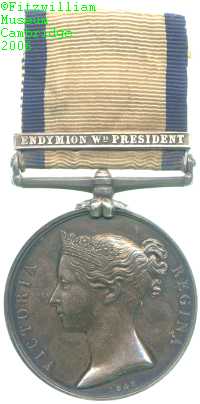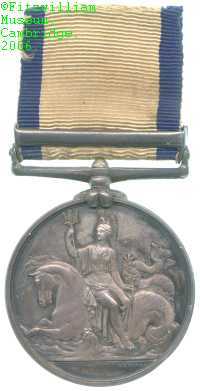
Obverse, a bust of Queen Victoria

Reverse, Britannia with a trident seated sideways on a seahorse

Obverse, a bust of Queen Victoria |

Reverse, Britannia with a trident seated sideways on a seahorse |
Just as in 1848 the extensive land campaigns of the Napoleonic Wars and the other conflicts of the pre-Victorian era were recognised by the issue of the Miltary General Service Medal, those serving in the Navy at the time were recognised with the Naval General Service Medal. As with the Army equivalent and the East India Company's related award, many of the battles for which the medal was awarded had been fought so long ago that few if any claimants survived.
In addition, bars were awarded for many actions whose significance and size were, despite the heroism displayed by those involved, relatively minor. The result was that many of the bars were issued in tiny numbers, with some combinations all but unique, and the medals command a very high price among collectors because of this rarity and individuality. This in turn, along with the manufacture in most cases of more bars than were eventually issued, has led to the `improvement' of many common awards where recipients' names are shared with those present at `rarer' battles. The medal also shares with the Military General Service and Army of India Medals the oddity that Queen Victoria, whose portrait they bear, was not the ruler under whom the battles for which it was awarded were fought.
This medal was awarded for a battle of the American `War of 1812'. As well as being extensively committed against the French in the Napoleonic Wars the Royal Navy of the early nineteenth century was occupied against United States forces on the western side of the Atlantic. In 1815 one of His Majesty's ships there was HMS Endymion, a veteran of the Dardanelles and officially the fastest-sailing ship in the Navy. When she and her squadron caught the frigate USS President attempting to run the Navy's blockade off New York, therefore, it was Endymion alone which was able to overhaul her. The following running fight took the two ships nearly as far as the Caribbean before President managed to damage Endymion's sails enough to escape. By this stage, however, President herself was much slowed, and when Endymion, with jury-rigged sails and the rest of the British squadron now in company, managed to catch her, her captain surrendered. Exactly which of the ships had won the battle is thus something of an open question.
This battle is unusual in that it was recognised by a contemporary award, albeit an unofficial one, but no-one beyond the Endymion's officers received this.
This medal was however awarded to Thomas Rowlands, who was verifiably a Ship's Boy on the Endymion at the time. The Medals Roll also confirms the award of the piece to him. Lester Watson purchased this medal at some point before 1928; it had previously formed part of the Whalley Collection.